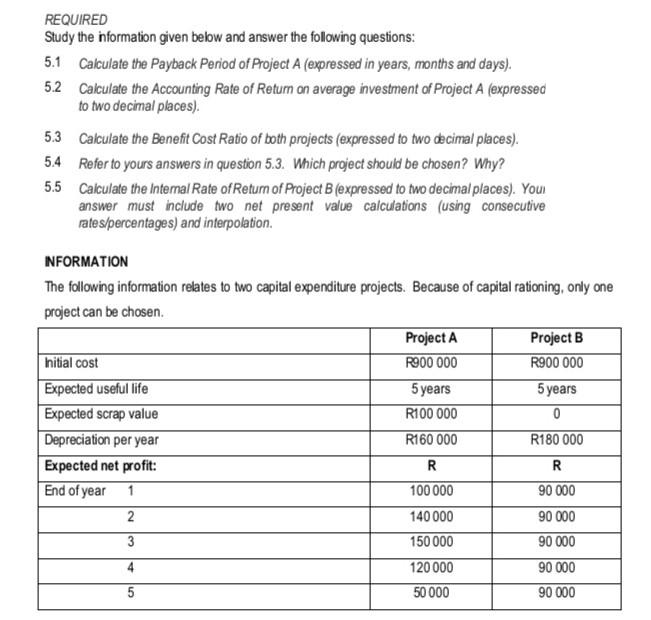REQUIRED Study the information given below and answer the following questions: 5.1 Calculate the Payback Period of Project A (expressed in years, months and days). Calculate the Accounting Rate of Return on average investment of Project A (expressed to two decimal places). 5.2 5.3 Calculate the Benefit Cost Ratio of both projects (expressed to two decimal places). 5.4 Refer to yours answers in question 5.3. Which project should be chosen? Why? 5.5 Calculate the Internal Rate of Return of Project B (expressed to two decimal places). Your answer must include two net present value calculations (using consecutive rates/percentages) and interpolation. INFORMATION The following information relates to two capital expenditure projects. Because of capital rationing, only one project can be chosen. hitial cost Expected useful life Expected scrap value Depreciation per year Expected net profit: End of year 1 2 3 4 5 Project A R900 000 5 years R100 000 R160 000 R 100 000 140 000 150 000 120 000 50 000 Project B R900 000 5 years 0 R180 000 R 90 000 90 000 90 000 90 000 90 000
REQUIRED Study the information given below and answer the following questions: 5.1 Calculate the Payback Period of Project A (expressed in years, months and days). Calculate the Accounting Rate of Return on average investment of Project A (expressed to two decimal places). 5.2 5.3 Calculate the Benefit Cost Ratio of both projects (expressed to two decimal places). 5.4 Refer to yours answers in question 5.3. Which project should be chosen? Why? 5.5 Calculate the Internal Rate of Return of Project B (expressed to two decimal places). Your answer must include two net present value calculations (using consecutive rates/percentages) and interpolation. INFORMATION The following information relates to two capital expenditure projects. Because of capital rationing, only one project can be chosen. hitial cost Expected useful life Expected scrap value Depreciation per year Expected net profit: End of year 1 2 3 4 5 Project A R900 000 5 years R100 000 R160 000 R 100 000 140 000 150 000 120 000 50 000 Project B R900 000 5 years 0 R180 000 R 90 000 90 000 90 000 90 000 90 000
Managerial Economics: A Problem Solving Approach
5th Edition
ISBN:9781337106665
Author:Luke M. Froeb, Brian T. McCann, Michael R. Ward, Mike Shor
Publisher:Luke M. Froeb, Brian T. McCann, Michael R. Ward, Mike Shor
Chapter5: Investment Decisions: Look Ahead And Reason Back
Section: Chapter Questions
Problem 5.4IP
Related questions
Question
100%

Transcribed Image Text:REQUIRED
Study the information given below and answer the following questions:
5.1 Calculate the Payback Period of Project A (expressed in years, months and days).
Calculate the Accounting Rate of Return on average investment of Project A (expressed
to two decimal places).
5.2
5.3
Calculate the Benefit Cost Ratio of both projects (expressed to two decimal places).
5.4 Refer to yours answers in question 5.3. Which project should be chosen? Why?
5.5
Calculate the Internal Rate of Return of Project B (expressed to two decimal places). Your
answer must include two net present value calculations (using consecutive
rates/percentages) and interpolation.
INFORMATION
The following information relates to two capital expenditure projects. Because of capital rationing, only one
project can be chosen.
Initial cost
Expected useful life
Expected scrap value
Depreciation per year
Expected net profit:
End of year
1
2
3
4
5
Project A
R900 000
5 years
R100 000
R160 000
R
100 000
140 000
150 000
120 000
50 000
Project B
R900 000
5 years
0
R180 000
R
90 000
90 000
90 000
90 000
90 000
Expert Solution
This question has been solved!
Explore an expertly crafted, step-by-step solution for a thorough understanding of key concepts.
This is a popular solution!
Trending now
This is a popular solution!
Step by step
Solved in 4 steps

Follow-up Questions
Read through expert solutions to related follow-up questions below.
Follow-up Question
Can I please get the solution for question 5.4 and 5.5
Solution
Knowledge Booster
Learn more about
Need a deep-dive on the concept behind this application? Look no further. Learn more about this topic, economics and related others by exploring similar questions and additional content below.Recommended textbooks for you

Managerial Economics: A Problem Solving Approach
Economics
ISBN:
9781337106665
Author:
Luke M. Froeb, Brian T. McCann, Michael R. Ward, Mike Shor
Publisher:
Cengage Learning

Managerial Economics: Applications, Strategies an…
Economics
ISBN:
9781305506381
Author:
James R. McGuigan, R. Charles Moyer, Frederick H.deB. Harris
Publisher:
Cengage Learning

Managerial Economics: A Problem Solving Approach
Economics
ISBN:
9781337106665
Author:
Luke M. Froeb, Brian T. McCann, Michael R. Ward, Mike Shor
Publisher:
Cengage Learning

Managerial Economics: Applications, Strategies an…
Economics
ISBN:
9781305506381
Author:
James R. McGuigan, R. Charles Moyer, Frederick H.deB. Harris
Publisher:
Cengage Learning